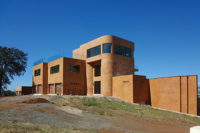


Hybrid tools
Before discussing the tools in photo 1 individually, the difference in the corners of the tools should first be noted. Some are square, while others are rounded, though all of these tools are available both ways. The rounded corners are available for a couple of reasons.
The first should be familiar to all drywall finishers who remember when they first started. While trying to smooth out areas of wet joint compound that are wider than the knife being used, there was the ominous railroad track from the edge of the knife as it was pulled through the compound.

Another reason for the round style tools are they help with applying plaster into inside corners. They provide a snowplow-like effect whereas the scraping in the corner caused by the sharp-cornered tools may affect the tones and hue in the color of the completed finish.
The third reason is simply that the difference in corners offer different finish appearances. Subtle differences in the application of plasters can greatly affect overall finish appearance. The tools of the trade in photo 1 (clockwise from noon) are Japanese scrapers, double blades, plastering knife and trowels.

Simply classic
Japanese scrapers are what I will concentrate on in this article and will cover the others in future writing. In my opinion, scrapers are the mainstay of Venetian plastering. Scrapers come in packages of four blades\scrapers ranging in size from approximately 1 1/4 to 4 inches. This will vary some between different manufacturers. These tools are used for what I learned to be the “classic” Venetian plastering technique. I’m not sure I agree with this anymore as the results of my research shows that how things were done in antiquity really depends on where the tradesman practiced his trade (“classic” to one may not be classic to another).

Some applicators use very thin applications and slowly build up the thickness (photo 5). Others will remove less. The thinner the plaster application, the more translucent the plaster and the more movement in the plaster will show through. This can be seen in the picture by the underlying basecoat of paint showing through the plaster. This technique will also affect color if more than one color is used. Thick applications will bury the underlying color(s).

Patience and skill
Using scrapers is a very slow, labor-intensive process. The applicator starts with the largest blade, works through to the smallest and follows the same process through each blade size. I am often asked why the tools are so small. I remember asking the same question. The answer is certain finishes can only be obtained by using certain tools.





Sidebar: Big City Nights
In December 2002, I was invited to participate in a TexSton class at its studio in Los Angeles. I have often used the company’s plasters, so I took advantage of the kind offer. Another motivation for taking this class was that I had never taken a product\manufacturer-based class before. My roots in Venetian plastering were self-taught. Drywall and conventional plastering were not new to me but this was. I was fortunate through my faux and decorative painting work to know many people in the faux community who were eager and willing to help me. Over time, I did take classes and train with various people but the training never centered on one product line.One immediate difference with this training was the others in attendance. All but one was a fellow contractor. From my training with faux artists, I was almost always the lone contractor while everyone else was a faux artist.
Besides the different personality of the class from my previous experience, many of the plastering basics were bypassed and more emphasis was put on integrating Venetian plastering with the more conventional skills of a drywall finisher and plasterer. The lone faux artist participating in the training was not ignored though. In fact, from all the others present, he actually received more attention for his basic deficiencies than he ever would have received from participation in other training among his own peers. He left this training with knowledge of skills he would have never received otherwise in that short of a time.
Another quick note to remember: A lot of people and places limit training to small sample boards. This does not allow for any experience with an instructor present plastering on a wall surface. Pursue training someplace that offers at least some instruction on full sheets of drywall.
What the training covered was all of the company’s product line, various techniques of application, a long list of what to do, and what not to do and a lecture on various ways the company’s plasters have been successfully used on various jobs. The “what to do/what not to do” is very important because the various Venetian plasters are not identical. I’ve seen more than one on-site failure because the plasterer assumed what had been done with one plaster in the past could be done with any plaster.
One unique finish of this manufacturer involves what it calls a “wet-on-wet” finish. This is exactly what its name implies: the application of a plaster coat on top of an underlying coat that has not dried. Obviously, the timing of this is very important but it is not a finish anyone can assume be accomplished with another plaster. Another important factor of Venetian plastering is the colorants used. Many will accept conventional paint universal colorants, but a lot of the plasters are too hot for these colorants and will slowly eat away at the color in the plaster. For these plasters, natural oxide colorants are required. This affects the color palate that a particular plaster can be offered in.
I would highly recommend pursuing training to begin to develop Venetian plastering skills. In my own situation, even with the pre-acquired skills I brought to the table, my learning curve would have been much shorter than what I did experience.



